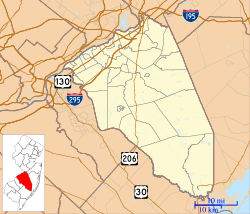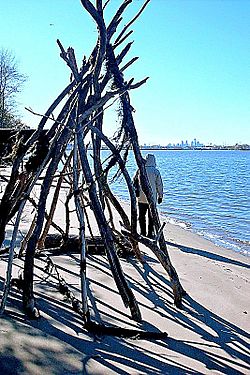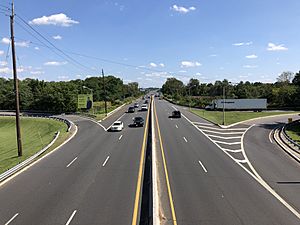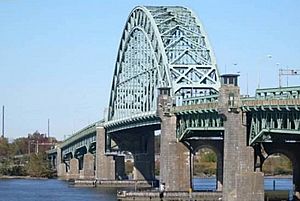Palmyra, New Jersey facts for kids
Quick facts for kids
Palmyra, New Jersey
|
|
|---|---|
|
Borough
|
|
| Borough of Palmyra | |
| Motto(s):
"A Place to Grow"
|
|

Palmyra highlighted in Burlington County. Inset map: Burlington County highlighted in the State of New Jersey.
|
|

Census Bureau map of Palmyra, New Jersey
|
|
| Country | |
| State | |
| County | |
| Incorporated | April 19, 1894 |
| Named for | Palmyra, Syria |
| Government | |
| • Type | Borough |
| • Body | Borough Council |
| Area | |
| • Total | 2.54 sq mi (6.58 km2) |
| • Land | 1.85 sq mi (4.79 km2) |
| • Water | 0.69 sq mi (1.79 km2) 27.28% |
| Area rank | 371st of 565 in state 32nd of 40 in county |
| Elevation | 7 ft (2 m) |
| Population | |
| • Total | 7,398 |
| • Estimate
(2019)
|
7,140 |
| • Rank | 309th of 566 in state 23rd of 40 in county |
| • Density | 3,968.4/sq mi (1,532.2/km2) |
| • Density rank | 155th of 566 in state 7th of 40 in county |
| Time zone | UTC−05:00 (Eastern (EST)) |
| • Summer (DST) | UTC−04:00 (Eastern (EDT)) |
| ZIP Code |
08065
|
| Area code(s) | 856 exchanges: 303, 726, 829, 786 |
| FIPS code | 3400555800 |
| GNIS feature ID | 0885339 |
| Website | |
Palmyra is a borough in Burlington County, New Jersey, United States. As of the 2010 United States Census, the borough's population was 7,398, reflecting an increase of 307 (+4.3%) from the 7,091 counted in the 2000 Census, which had in turn increased by 35 (+0.5%) from the 7,056 counted in the 1990 Census.
Palmyra was originally incorporated as a township by an act of the New Jersey Legislature on April 19, 1894, from portions of Cinnaminson Township and Riverton. On February 20, 1923, Palmyra was reincorporated as a borough.
Contents
History
The area that is now Palmyra was settled in the late 17th century by Swedes, marking the northernmost border of New Sweden. A farmhouse built in 1761 by the third generation settlers still remains as the oldest house in Palmyra. Farming was the primary use of land in Palmyra and the surrounding area until after the construction of the Camden and Amboy Railroad in 1834 with a station in the area, after which railroad workers built homes on lots they purchased along the railroad right of way. The community was originally known as Texas, but a local landowner, Isaiah Toy, a descendant of the original Swedish settlers and a stockholder in the Camden and Amboy Railroad, who wanted to have a post office established in the community, convinced the railroad to change the name of the station in 1849 to Palmyra, which came from his love of ancient history. Palmyra was the name of an ancient trading center located in central Syria. The post office was established in 1851. Palmyra, along with Bordentown, Burlington, Moorestown Township, and Mount Holly Township, established its high school in the late 1890s, making it one of the oldest high schools in Burlington County and in New Jersey.
The community was laid out in 1850, when Joseph Souder's land was broken up into building lots to pay his debts, with the street names matching those of Center City, Philadelphia - Market, Arch, Race, and Vine (from south to north), and Front Street and numbered streets from the Delaware River. What is now Palmyra was part of Chester Township (now Maple Shade Township), which was created in 1694 and was one of the original 104 townships in New Jersey incorporated in 1798. Palmyra became a part of Cinnaminson Township when that township was set off from Chester in 1860. Palmyra Township was set off from Cinnaminson in 1894, and Palmyra was incorporated as a borough in 1923.
Geography
According to the United States Census Bureau, the borough had a total area of 2.550 square miles (6.605 km2), including 1.864 square miles (4.828 km2) of land and 0.686 square miles (1.777 km2) of water (26.90%).
Unincorporated communities, localities and place names located partially or completely within the borough include West Palmyra.
The borough borders Cinnaminson Township and Riverton in Burlington County; Pennsauken Township in Camden County; and Philadelphia across the Delaware River in Pennsylvania.
The city is connected to the Tacony section of Philadelphia via Route 73 by the Tacony-Palmyra Bridge, which is named for the two communities connected by the bridge. The bridge was completed in 1929 at a cost of $4 million.
In 1999, a 250-acre (100 ha) nature park, Palmyra Nature Cove, was opened along the banks of the Delaware which borders Palmyra on the west; in addition to serving as a bird sanctuary, the park offers educational programs for schools and hiking trails for walkers. The park is open from dawn to dusk; no pets or bicycles are allowed.
Demographics
| Historical population | |||
|---|---|---|---|
| Census | Pop. | %± | |
| 1880 | 571 | — | |
| 1890 | 1,903 | 233.3% | |
| 1900 | 2,300 | 20.9% | |
| 1910 | 2,801 | 21.8% | |
| 1920 | 3,834 | 36.9% | |
| 1930 | 4,968 | 29.6% | |
| 1940 | 5,178 | 4.2% | |
| 1950 | 5,802 | 12.1% | |
| 1960 | 7,036 | 21.3% | |
| 1970 | 6,969 | −1.0% | |
| 1980 | 7,085 | 1.7% | |
| 1990 | 7,056 | −0.4% | |
| 2000 | 7,091 | 0.5% | |
| 2010 | 7,398 | 4.3% | |
| 2019 (est.) | 7,140 | −3.5% | |
| Population sources: 1880-1890 1900-2000 1900-1920 1900-1910 1910-1930 1930-1990 2000 2010 |
|||
Census 2010
As of the census of 2010, there were 7,398 people, 3,156 households, and 1,938 families residing in the borough. The population density was 3,968.4 per square mile (1,532.2/km2). There were 3,392 housing units at an average density of 1,819.5 per square mile (702.5/km2)*. The racial makeup of the borough was 78.75% (5,826) White, 14.54% (1,076) Black or African American, 0.31% (23) Native American, 1.84% (136) Asian, 0.08% (6) Pacific Islander, 1.95% (144) from other races, and 2.53% (187) from two or more races. [[Hispanic (U.S. Census)|Hispanic or Latino of any race were 5.37% (397) of the population.
There were 3,156 households out of which 23.5% had children under the age of 18 living with them, 43.1% were married couples living together, 13.1% had a female householder with no husband present, and 38.6% were non-families. 31.5% of all households were made up of individuals, and 9.6% had someone living alone who was 65 years of age or older. The average household size was 2.34 and the average family size was 2.97.
In the borough, the population was spread out with 19.5% under the age of 18, 7.4% from 18 to 24, 28.6% from 25 to 44, 31.3% from 45 to 64, and 13.2% who were 65 years of age or older. The median age was 41.0 years. For every 100 females there were 95.1 males. For every 100 females ages 18 and old there were 91.2 males.
The Census Bureau's 2006-2010 American Community Survey showed that (in 2010 inflation-adjusted dollars) median household income was $61,990 (with a margin of error of +/- $3,744) and the median family income was $74,265 (+/- $6,025). Males had a median income of $53,295 (+/- $6,313) versus $48,417 (+/- $6,580) for females. The per capita income for the borough was $30,361 (+/- $2,319). About 6.5% of families and 7.6% of the population were below the poverty line, including 16.0% of those under age 18 and 4.2% of those age 65 or over.
Census 2000
As of the 2000 United States Census there were 7,091 people, 3,004 households, and 1,853 families residing in the borough. The population density was 3,586.9 people per square mile (1,382.8/km2). There were 3,219 housing units at an average density of 1,628.3 per square mile (627.7/km2). The racial makeup of the borough was 80.99% White, 14.34% African American, 0.30% Native American, 1.40% Asian, 0.04% Pacific Islander, 1.41% from other races, and 1.52% from two or more races. Hispanic or Latino of any race were 3.23% of the population.
There were 3,004 households, out of which 26.7% had children under the age of 18 living with them, 45.1% were married couples living together, 12.5% had a female householder with no husband present, and 38.3% were non-families. 32.0% of all households were made up of individuals, and 10.1% had someone living alone who was 65 years of age or older. The average household size was 2.36 and the average family size was 3.02.
In the borough the population was spread out, with 22.3% under the age of 18, 6.9% from 18 to 24, 33.5% from 25 to 44, 23.7% from 45 to 64, and 13.5% who were 65 years of age or older. The median age was 38 years. For every 100 females, there were 93.2 males. For every 100 females age 18 and over, there were 87.8 males.
The median income for a household in the borough was $51,150, and the median income for a family was $57,192. Males had a median income of $42,910 versus $31,445 for females. The per capita income for the borough was $23,454. About 2.2% of families and 4.2% of the population were below the poverty line, including 7.2% of those under age 18 and 2.4% of those age 65 or over.
Transportation
Roads and highways
As of May 2010[update], the borough had a total of 27.67 miles (44.53 km) of roadways, of which 23.04 miles (37.08 km) were maintained by the municipality, 3.11 miles (5.01 km) by Burlington County, 0.98 miles (1.58 km) by the New Jersey Department of Transportation and 0.54 miles (0.87 km) by the Burlington County Bridge Commission.
Route 73 traverses the borough, connecting to the Burlington County Bridge Commission-operated Tacony-Palmyra Bridge at the roadway's northern terminus and interchanging with County Route 543, most of which is called Broad Street within Palmyra.
Public transportation
The Palmyra station on NJ Transit's River Line light rail system is located on East Broad Street. The station opened on March 15, 2004. Southbound service from the station is available to Camden, including a transfer to the PATCO Speedline available at the Walter Rand Transportation Center. Northbound service is available to the Trenton Rail Station with connections to NJ Transit trains to New York City, SEPTA trains to Philadelphia, and Amtrak trains.
NJ Transit provides bus service in the borough on the 419 route that runs between Camden and Burlington.
Education
The Palmyra Public Schools serves students in pre-kindergarten through twelfth grade from Palmyra, along with those from Beverly and Riverton who attend the district's high school as part of sending/receiving relationships. As of the 2018–19 school year, the district, comprised of two schools, had an enrollment of 953 students and 79.0 classroom teachers (on an FTE basis), for a student–teacher ratio of 12.1:1. Schools in the district (with 2018–19 enrollment from the National Center for Education Statistics) are: Charles Street Elementary School with 457 students in grades PreK-6 and Palmyra Middle School / Palmyra High School with 468 students in grades 7-12
Students from Palmyra, and from all of Burlington County, are eligible to attend the Burlington County Institute of Technology, a countywide public school district that serves the vocational and technical education needs of students at the high school and post-secondary level at its campuses in Medford and Westampton Township.
Notable people
People who were born in, residents of, or otherwise closely associated with Palmyra include:
- Jim Bailey (born 1949), singer, film, television and stage actor, and female impersonator.
- Lena Blackburne (1886–1968), major league baseball player and manager best known for his discovery of a mud in a tributary of the Delaware River near Palmyra which is still used to rub down baseballs, allowing pitchers to gain better control over the ball.
- Jack Casey (born 1935), member of the New Jersey Senate and General Assembly, who also served as mayor of Palmyra.
- Robert K. Crane (1919-2010), biochemist best known for his discovery of sodium-glucose cotransport.
- Calvin T. Durgin (1893-1965), Vice Admiral who served in the U.S. Navy from 1916 until 1951, and was Deputy Chief of Naval Operations for Air in 1949.
- Kelvin Harmon (born 1997), wide receiver for the Washington Commanders of the NFL.
- Clarence Benjamin Jones (born 1931), lawyer and former personal counsel, advisor, draft speech writer and close friend of Martin Luther King Jr.
- Frank A. Mathews Jr. (1904–1964), represented New Jersey's 4th congressional district in the United States House of Representatives from 1945 to 1949.
- Quron Pratt (born 1991), Philadelphia Eagles wide receiver since 2014.
- A. Raymond Randolph (born 1943), federal judge on the United States Court of Appeals for the District of Columbia Circuit who was appointed to the court in 1990.
- Troy Singleton (born 1973), member of the New Jersey General Assembly since 2011.
- August Weikman (1860–1924), was serving as the Commodore Barber on the RMS Titanic when the ship hit an iceberg on its maiden voyage and sank on April 14, 1912.
See also
 In Spanish: Palmyra (Nueva Jersey) para niños
In Spanish: Palmyra (Nueva Jersey) para niños








